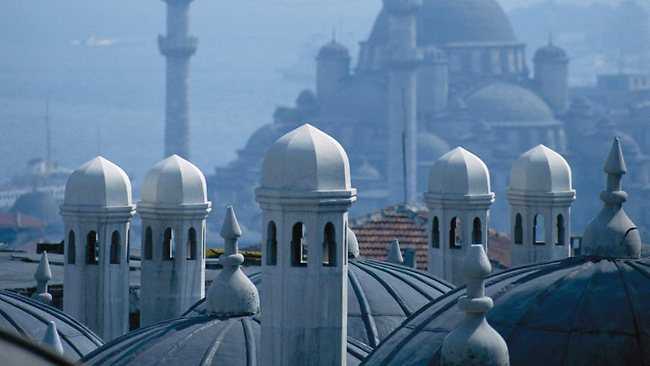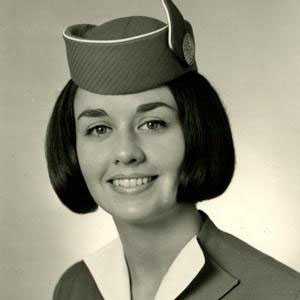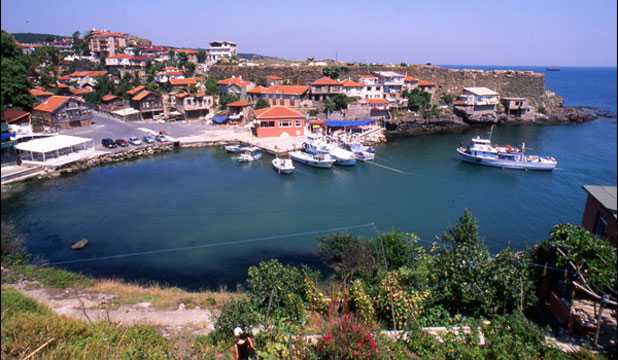Skyline of Istanbul, Turkey. Picture: Thinkstock
The Blue Mosque in Istanbul, Turkey. Picture: Supplied.

BE prepared to be carpeted when you visit this wonderfully cosmopolitan Turkish city, writes Mike O’Connor.
NAKED, save for the distressingly small towel wrapped around my waist, I lay on the marble slab and gazed at the light streaming through the domed ceiling as the sweat rolled off me in rivers.
This was a real Turkish bath in Turkey. The Cemberlitas hammam, built in 1584. A minute’s walk from Istanbul’s Grand Bazaar. The large Turkish gentleman confronting me knew but two words of English “sit” and “lie”.
I did as ordered and he soaped my body with a sponge, doused me with buckets of warm water and then pummelled and kneaded me for 30 minutes, before handing me over to a colleague who massaged me with hands of steel. The pain was excruciating. I wanted to cry. Maybe I did, just a little.
After two hours and several more trips to the steam room, I emerged into the bright light of Istanbul feeling mangled but undeniably clean.
Istanbul’s old city overwhelms the visitor with the wail of sirens, the clanging of tram bells and the crush of locals, tourists and hustlers as they jostle for space in this city of about 13 million people which was first settled about 1100BC.
It is undeniably exotic, the old city surrounded by mosques and castles built on a site that has been occupied by the Byzantines, Persians, Greeks, Romans and, more lately, the Muslim Ottoman sultans.
It is bordered by the Bosporus, that river-like body of water that connects the Sea of Marmara to the Black Sea and the former Soviet socialist republics that lie beyond.
The Golden Horn, an inlet of the Bosporus, divides the city and the seven hills that surround it.
If you were to travel by boat downstream from Istanbul, heading down the Bosporus and across the Sea of Marmara, you would eventually come to another narrow seaway.
It is one the Allies tried to penetrate in World War I, their failure to do so resulting in the name Gallipoli being writ large in Australian military history.
We picked up a brochure for a day trip to Gallipoli, which left at dawn and returned about 10pm. A day spent in a bus didn’t appeal and Gallipoli was left for another day and another trip.
Our hotel was on the tram line that runs through the heart of the old city, which proved to be a significant advantage. The fare was two Turkish lira no matter how many stops you travelled, the trams modern and clean.
We watched from the upper level of a double-decker Red Bus tour as a black Volkswagen cut across a lane of traffic, clipped the side of a mini-van and slammed into a tree, exploding in a shower of broken glass and steam.
A few seconds later the driver emerged, talking into his mobile phone and apparently unhurt, his car just another casualty of the insane driving habits of Istanbullahs.
Take a Red Bus tour a get-on, get-off journey around the city, which crosses the Golden Horn to Taksim Square, returning to the Blue Mosque.
We sipped coffee and ate pastries stuffed with spinach and fetta cheese most mornings before catching a tram to Sultanahmet, where the parklands surrounding the Blue Mosque were packed with tourists.
Late one afternoon, tiring of the throng, we retired to the rooftop bar of the Seven Hills Hotel in the shadow of the Blue Mosque with a magnificent 270-degree view across the Bosporus at its confluence with the Golden Horn.
At 4.30pm, as the light began to soften, a voice cut through the warm air, high-pitched and plaintive as the muezzin called the faithful to prayer. Soon it was joined by another and then another, a stereo exhortation echoing over the roofs of the city.
On another day we caught a tram to Kabatas and then a funicular to Taksim Square and strolled down the broad streets that radiate from it, stopping for coffee and baklava. The streets are lined with some of Istanbul’s better retail outlets, with dark, narrow laneways disappearing down steep hills and all lined with small shops and stalls.
Rather than take an organised tour, we jumped on a ferry heading up the Bosporus. It was a journey of about two hours past the mansions of Istanbul’s more prosperous citizens. We disembarked at Kavagi and caught a local bus, which for two lira gave us an hour-long journey through the pine forests and towns that cling to the Bosporus’s banks on the Asian side, before depositing us back to the city.
The next day we plunged into the Grand Bazaar, home to 4000 shops. It’s a bewildering, although surprisingly orderly, market selling quality copies of high-end fashion label clothing, jewellery, handbags, homewares, furnishings, tourist tack, quality ceramics, brass, silverware and carpets by the thousand. You haggle for everything and the first offer is half the asking price.
We had sworn before leaving Australia that we were absolutely not going to buy a carpet. Then we walked into Yagmur Rugs Gallery Carpets and Kilims, where we met a man who had once sold carpets at Brisbane’s Home Show and who claimed to have been interviewed by Ray Martin.
Surely he had to be fair dinkum so we sat and drank some impossibly sweet rose tea in tiny cups. Perhaps we would like to see a carpet? Just one or two? Suddenly staff and carpets began to appear.
The haggling started. We eventually did a deal and walked out owning a carpet, which duly arrived, to our considerable relief, 10 days after we got back to Australia. Did we pay too much? Who knows? But we love it.
There must be some good restaurants in Istanbul. I know there are some terrible ones and anything within two blocks of the main tram line I would treat with suspicion. The one good meal we had was at The Fish House restaurant in Sultanahmet. Try the sea bass baked in a salt crust.
Istanbul is one of the world’s great cities. It’s exotic, cosmopolitan, uniquely placed between Europe and Asia and, as I discovered when I was relieved of a pair of reading glasses while riding the tram, boasts some of the world’s most skilled pickpockets.
The writer was a guest of Emirates and Creative Holidays.
—
ISTANBUL
Getting there
Emirates flies from Sydney to Istanbul via Dubai.
See emirates.com.au
Staying there
Creative Holidays has a five-night package staying at the Ramada Istanbul Old City for $480 a person, twin share.
See creativeholidays.com.au






